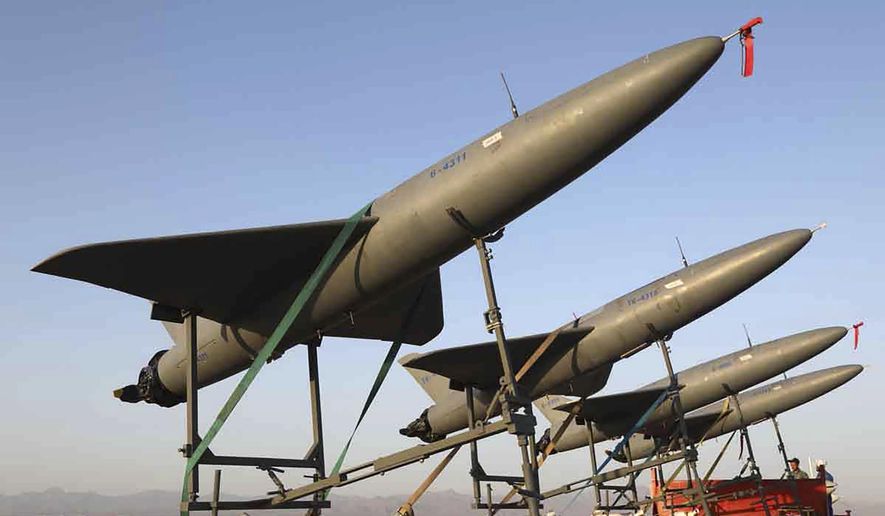
‘Terror weapon’: With starring role in Ukraine, Iran’s drones poised to become even more lethal

By Ben Wolfgang – The Washington Times – Saturday, November 5, 2022
Iran is poised to emerge from the Russia–Ukraine war as a much more dangerous adversary, analysts and national security insiders warn, as its military drone program is transforming into a lethal “terror weapon” that could eventually challenge some of the world’s most advanced defensive systems.
For the regime in Tehran, Russia‘s growing reliance on Iranian-made drones for its fall aerial campaign in Ukraine carries a host of benefits, including the deepening of diplomatic and military ties between the two countries at a time when Iran is increasingly isolated from the West.
But specialists say there’s a more troubling motivation, one that could carry very real ramifications for the national security of the U.S. and its allies, including Israel. Russia‘s battlefield use of Iranian-made Shahed-136 drones and other craft is giving Tehran real-time information on how its unmanned systems perform in a combat zone, which defensive systems they’re able to defeat, and what their biggest weaknesses appear to be. That knowledge will guide Iran‘s effort to refine its drones, making them even more effective and deadly in the future.
“While the U.S. and NATO will reap the benefits of the Ukrainian military’s experience, so, too, will Iran. Iranians operating the drones from Crimea have front-row seats and can report back which drone attacks have penetrated which defenses, and where gaps in any defense systems may exist,” Katherine Zimmerman, a resident fellow at the American Enterprise Institute, wrote in a recent piece for The Hill. “Iran’s next generation of drones will be that much more difficult to stop.”
Wars have an ideal laboratory for refining and improving the capabilities of the soldiers and weaponry involved, from Nazi Germany’s lessons learned aiding Franco’s forces in the Spanish Civil War in the 1930s to the experience and know-how Russia‘s own forces gained fighting in support of the Bashar Assad regime in Syria for the past decade.
Ms. Zimmerman and other scholars are now sounding the alarm about the long-term repercussions of the Iran-Russia drone nexus in Ukraine and beyond.
SEE ALSO: Iran acknowledges sending drones to Russia for first time
“The variety of ways in which the Ukrainian military has thwarted Russian drone attacks is a testament to the array of defenses at its disposal,” she said. “But it also speaks to the ad hoc nature of the response, revealing vulnerabilities to increasingly sophisticated — and field-tested — Iranian technology, and it exposes an asymmetry in defending against the threat.”
Indeed, the Ukrainian military’s ability to defeat Iranian drones is impressive. Ukrainian forces have shot down an estimated 70% of the hundreds of the low-flying, relatively slow Shahed 136 and 131 drones deployed by Russian troops and their Iranian allies in the fight so far, using a combination of missiles, machine-gun fire, fighter jets and other methods.
The Ukrainian success rate, while impressive, is only part of the story. Specialists warn that the Russian and Iranian militaries have learned that using swarms of Shahed drones — which cost as little as $20,000 a piece and are controlled via GPS systems — can overwhelm even the best of defenses.
Even if the majority of those drones are shot down, the survivors can carry out “suicide” attacks on Ukrainian targets, including energy infrastructure such as electrical power stations and water treatment facilities. The Shahed drones are particularly well-suited for that mission, according to Samuel Bendett, a senior fellow at the Center for a New American Security who is closely tracking daily battlefield developments in Ukraine.
“Russia fields this technology against stationary targets,” he said earlier this week at a Brookings Institution event focused on battlefield technology on display in Ukraine.
The Iranian drones, Mr. Bendett said, “are actually good at hitting stationary targets, not so much mobile targets that can maneuver quickly away from the original position.”
SEE ALSO: Iran Revolutionary Guard launches satellite-carrying rocket
“But this is also a very capable terror weapon, since Russia can send waves of the Shahed 136 and 131 drones against Ukrainian civilian infrastructure targets such as electrical power stations and heating power stations and other elements of infrastructure in order to terrorize and force the Ukrainian population and government to come to terms,” he said.
Still, analysts stress that the Shahed drones are by no means a game-changer for the Russian military and are highly unlikely to be a difference-maker in the overall trajectory of the war. And, for the record, Iranian officials continue to deny accounts of major shipments of arms and drones to Russia, insisting Tehran remains strictly neutral in the nearly nine-month war and that the U.S. and Ukraine are falsely accusing it of backing the Kremlin.
For the first time Saturday, a top Iranian official acknowledged Tehran had supplied the Russian military with drones, but insisted all shipments had been made well before the Feb. 24 invasion of Ukraine.
Iranian Foreign Minister Hossein Amirabdollahian said a “small number” of drones had been supplied to Russia a few months before the war began, Iran‘s state-controlled IRNA news service reported. But he again denied any drone shipments had been made after the war started and rejected other reports that Iran had sold powerful missiles to the Kremlin as well.
“This fuss made by some Western countries that Iran has provided missiles and drones to Russia to help the war in Ukraine, the missile part is completely wrong,” the official IRNA news agency quoted him as saying. “The drone part is true and we provided Russia a small number of drones months before the Ukraine war.”
Overwhelming defenses
The larger Shahed-136 is believed to have a range of at least about 620 miles, meaning the craft can be used virtually anywhere in Ukraine after being launched from the Crimean peninsula, where U.S. officials say Iranian military instructors are on the ground to teach Russian fighters how to use the craft.
The smaller Shahed-131 has a shorter range but is highly effective in more limited missions. Russian troops are able to launch the craft quickly and with little warning.
“The Shahed-136 can be fired from a mobile, truck-mounted launcher, making it difficult to detect,” John Hardie and Ryan Brobst, scholars with the think tank Foundation for Defense of Democracies, wrote in a recent analysis.
“The loitering munition is also difficult to detect by radar, thanks to its small size, low altitude and speed, and ability to change direction in flight and attack weak spots in air defense coverage,” they wrote. “The Ukrainians have achieved some success in downing them with surface-to-air missiles and even small-arms fire. But in sufficient numbers, the Shahed-136 can overwhelm Ukrainian air defenses, particularly at night, when Ukrainian troops have a harder time [tracking] the munition.”
The Kremlin appears to be doubling down on its strategy, as it is reportedly planning to buy thousands more Shahed drones from the Iranian government. Such a massive purchase will help backfill depleted Russian wartime supplies, which have dwindled rapidly as its forces have struggled to hold their ground against a spirited Ukrainian counterattack in the south and east.
For Iran, that amount of real-world battlefield experience is an important step forward for its drone program. Iranian proxies had already employed drones in Yemen, where Iran-backed Houthi rebels are battling government forces in a bloody civil war. Iran-backed militias in Iraq and Syria also have used drones to target U.S. forces stationed in both countries.
Iranian drones also appear to have been behind a 2019 attack on Saudi Arabian oil fields carried out by Houthi rebels.
But none of those instances have given Tehran the depth of information and invaluable experience as the Russia–Ukraine war.
In a future conflict, whether it be versus the U.S. or a regional adversary, Iran will almost surely be more dangerous thanks to that experience.
“Iran’s drone threat is rising, and it’s only a matter of time until the U.S. military, not the Ukrainians, will need to defend against it,” said Ms. Zimmerman, the AEI analyst.
• Ben Wolfgang can be reached at bwolfgang@washingtontimes.com.
Copyright © 2022 The Washington Times, LLC. Click here for reprint permission.
Please read our comment policy before commenting.
Comments
Related articles
- Reinventing after Globalization
- The Chiefs Forum: The Next 100 Days
- Subscriber Only Events
- Harm Reduction and Public Health
TODAY IN HOME
Classic versionPowered by

